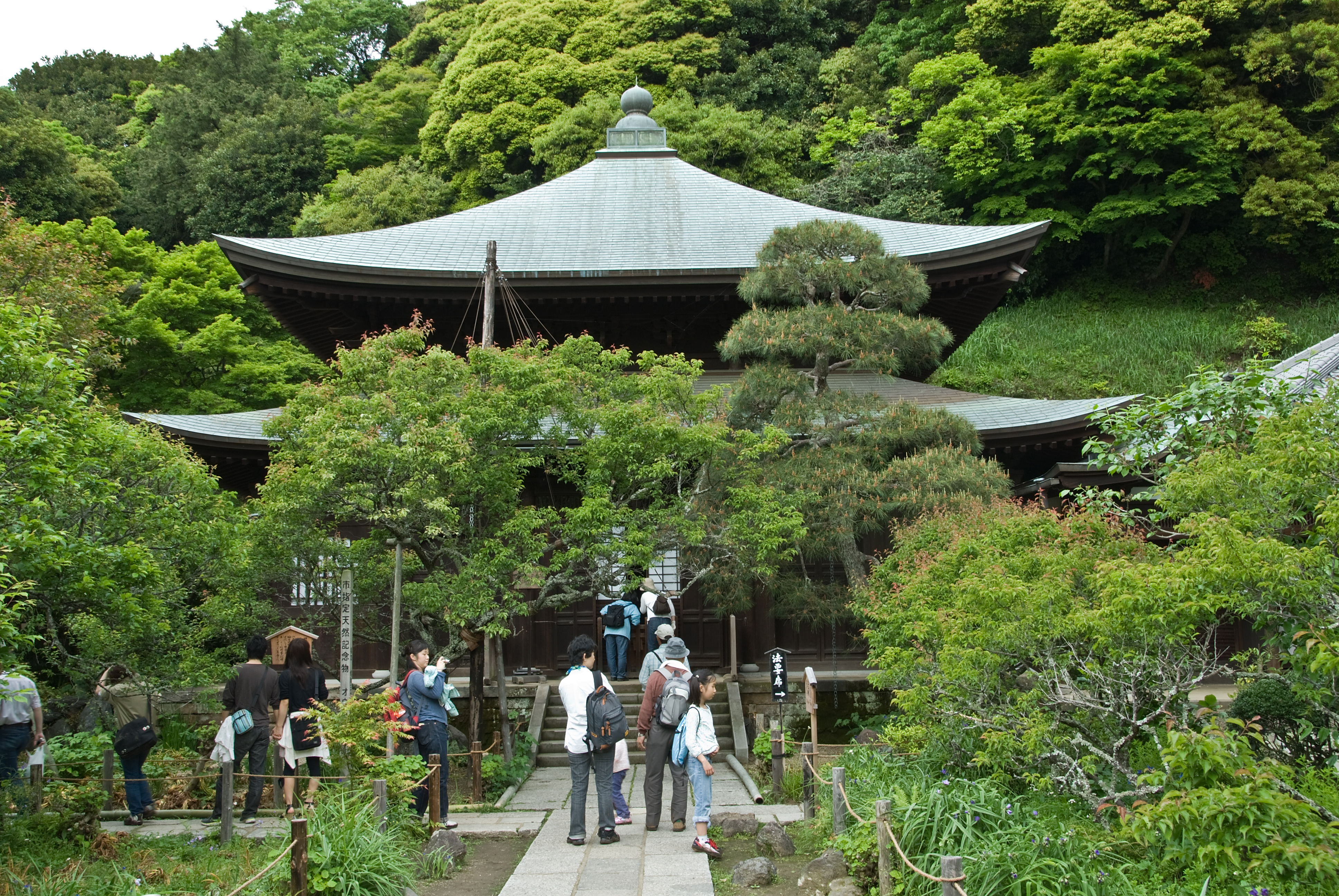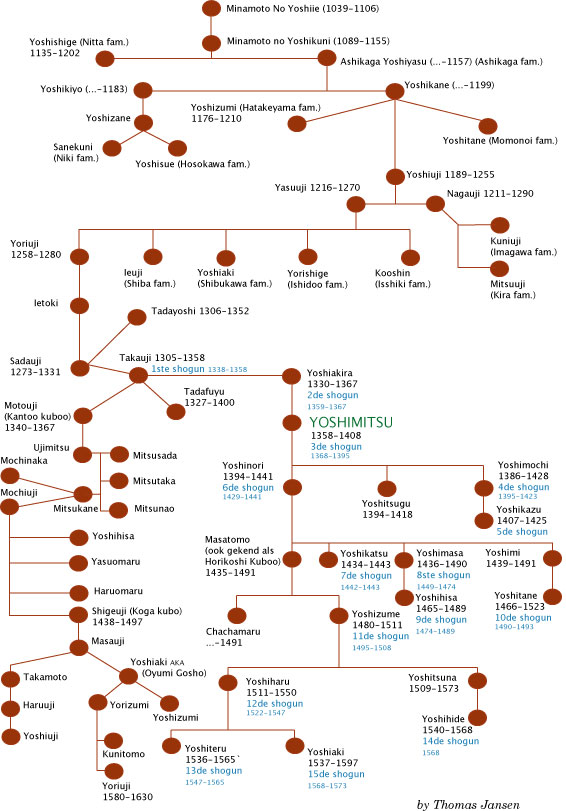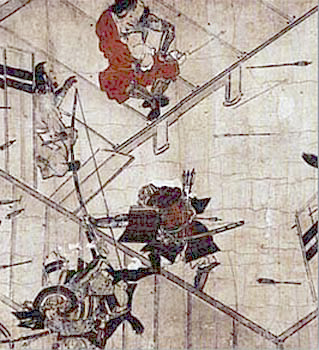|
Ashikaga Mitsukane
(1378–1409) was a Nanboku-chō period warrior, and the Kamakura-fu's third Kantō kubō, (''Shōgun'' Deputy). Being the eldest son, he succeeded his father Ujimitsu in 1398 at the age of 21 when he died during an epidemic. Like his father, Mitsukane aspired more or less openly to the shogunate and, like him and his successors, failed to obtain it. He died suddenly at the age of 32. Biography In 1399, the year after taking power, Mitsukane dispatched his sons Mitsunao and Mitsusada to Mutsu Province's Sasagawa Gosho and Inamura Gosho to stabilize the situation in the region which, together with Dewa Province, his father had received in 1392 from shogun Ashikaga Yoshimochi as a reward for his support against the Yamana clan.Kokushi Daijiten (1975:68) This because he realized the importance of the area to control the whole Kantō region. In August of the same year he stayed himself in Southern Mutsu, returning to Kamakura only four months later. This increased immensely the supp ... [...More Info...] [...Related Items...] OR: [Wikipedia] [Google] [Baidu] |
Zuisenji Main Hall Kamakura
is a Buddhist temple of the Rinzai sect in Nikaidō's in Kamakura, Japan.Kamiya (2008:98-102) During the Muromachi period it was the family temple of the Ashikaga rulers of Kamakura (the ''Kantō kubō''): four of the five ''kubō'' are buried there in a private cemetery closed to the public and first ''kubō'' Ashikaga Motouji's is also known by the name .Yasuda (1990:26) Designed by prominent Zen religious figure, poet and Zen garden designer Musō Soseki (also known as Musō Kokushi), the temple lies on top of an isolated hill and is famous for both its garden and its Zen rock garden. The beauty and the quantity of its plants have gained it since antiquity the nickname . The main object of worship is Jizō Bosatsu.Nihon Rekishi Chimei Taikei Zuisen-ji is an Historic Site and contains numerous objects classified as Important Cultural Properties and Places of Scenic Beauty. History Musō Soseki was not only the temple's founding priest, but also its main designer.Harada (2007:5 ... [...More Info...] [...Related Items...] OR: [Wikipedia] [Google] [Baidu] |
Ashikaga Yoshimitsu
was the third ''shōgun'' of the Ashikaga shogunate, ruling from 1368 to 1394 during the Muromachi period of Japan. Yoshimitsu was Ashikaga Yoshiakira's third son but the oldest son to survive, his childhood name being Haruō (). Yoshimitsu was appointed ''shōgun'', a hereditary title as head of the military estate, in 1368 at the age of ten; at twenty he was admitted to the imperial court as Acting Grand Counselor (''Gon Dainagon'' ). In 1379, Yoshimitsu reorganized the institutional framework of the Gozan Zen establishment before, two years later, becoming the first person of the warrior (samurai) class to host a reigning emperor at his private residence. In 1392, he negotiated the end of the Nanboku-chō imperial schism that had plagued politics for over half a century. Two years later he became Grand Chancellor of State ('' Dajō daijin'' ), the highest-ranking member of the imperial court. Retiring from that and all public offices in 1395, Yoshimitsu took the tonsure ... [...More Info...] [...Related Items...] OR: [Wikipedia] [Google] [Baidu] |
Ashikaga Clan
The was a prominent Japanese samurai clan which established the Muromachi shogunate and ruled Japan from roughly 1333 to 1573. The Ashikaga were descended from a branch of the Minamoto clan, deriving originally from the town of Ashikaga in Shimotsuke Province (modern-day Tochigi Prefecture). For about a century the clan was divided in two rival branches, the Kantō Ashikaga, who ruled from Kamakura, and the Kyōto Ashikaga, rulers of Japan. The rivalry ended with the defeat of the first in 1439. The clan had many notable branch clans, including the Hosokawa, Imagawa, Hatakeyama (after 1205), Kira , Shiba, and Hachisuka clans. After the head family of the Minamoto clan died out during the early Kamakura period, the Ashikaga came to style themselves as the head of the Minamoto, co-opting the prestige which came with that name. Another Ashikaga clan, not related by blood, and derived instead from the Fujiwara clan, also existed. History Emperor Go-Daigo 後醍醐天皇 ... [...More Info...] [...Related Items...] OR: [Wikipedia] [Google] [Baidu] |
Government Of Feudal Japan
A government is the system or group of people governing an organized community, generally a state. In the case of its broad associative definition, government normally consists of legislature, executive, and judiciary. Government is a means by which organizational policies are enforced, as well as a mechanism for determining policy. In many countries, the government has a kind of constitution, a statement of its governing principles and philosophy. While all types of organizations have governance, the term ''government'' is often used more specifically to refer to the approximately 200 independent national governments and subsidiary organizations. The major types of political systems in the modern era are democracies, monarchies, and authoritarian and totalitarian regimes. Historically prevalent forms of government include monarchy, aristocracy, timocracy, oligarchy, democracy, theocracy, and tyranny. These forms are not always mutually exclusive, and mixed governme ... [...More Info...] [...Related Items...] OR: [Wikipedia] [Google] [Baidu] |
People Of Nanboku-chō-period Japan
A person ( : people) is a being that has certain capacities or attributes such as reason, morality, consciousness or self-consciousness, and being a part of a culturally established form of social relations such as kinship, ownership of property, or legal responsibility. The defining features of personhood and, consequently, what makes a person count as a person, differ widely among cultures and contexts. In addition to the question of personhood, of what makes a being count as a person to begin with, there are further questions about personal identity and self: both about what makes any particular person that particular person instead of another, and about what makes a person at one time the same person as they were or will be at another time despite any intervening changes. The plural form "people" is often used to refer to an entire nation or ethnic group (as in "a people"), and this was the original meaning of the word; it subsequently acquired its use as a plural form of per ... [...More Info...] [...Related Items...] OR: [Wikipedia] [Google] [Baidu] |
Kokushi Daijiten
The ''Kokushi Daijiten'' (国史大辞典 literally "Great Dictionary of National History") all no.: REF DS 833 .K64, (Vol. 1)is a large, general history dictionary of Japan published by the Tokyo-based company Yoshikawa Kobunkan. The original edition consisted of six volumes and was published in 1927. The current edition was written and released over a period of 18 years, beginning in 1979 and ending in 1997. General The ''Kokushi Daijiten'' consists of a total of 14 volumes of entries in addition to three index volumes (numbered as vol. 15 upper, middle, and lower). A remarkable feature of the dictionary is the inclusion of large, high-quality glossy color plates and maps in addition to black and white illustrations that accompany entries in the text. Organization The dictionary is organized following the Japanese phonetic syllabary beginning with "a", as opposed to the iroha order. Entries are titled in hiragana or katakana as appropriate, then followed by kanji or ... [...More Info...] [...Related Items...] OR: [Wikipedia] [Google] [Baidu] |
Ashikaga Mochiuji
Ashikaga Mochiuji (, 1398–1439) was the Kamakura-fu's fourth Kantō kubō during the Sengoku period (15th century) in Japan. During his long and troubled rule the relationship between the west and the east of the country reached an all-time low. Kamakura was finally attacked by ''shōgun'' Ashikaga Yoshinori and retaken by force. Mochiuji and his eldest son Yoshihisa killed themselves to escape capture. Biography Mochiuji became ''Kubō'' while still a child after his father died suddenly of a disease. His violent and abrasive character from the beginning caused widespread resentment among his vassals. After disagreements with Mochiuji, his ''kanrei'' Uesugi Zenshū organized a rebellion against him (the so-called ''Zenshū no Ran'') with the aid of nearly half the ''daimyōs'' in the northern and eastern provinces. Thanks to this support, Zenshū could take Kamakura and Mochiuji had to flee. However, despite his pursuing goals similar to those of the shogunate, Zenshū was afte ... [...More Info...] [...Related Items...] OR: [Wikipedia] [Google] [Baidu] |
Kantō Kubō
(also called , , or ) was a title equivalent to ''shōgun'' assumed by Ashikaga Motouji after his nomination to ''Kantō kanrei'', or deputy shōgun for the Kamakura-fu, in 1349.Kokushi Daijiten (1983:542) Motouji transferred his original title to the Uesugi family, which had previously held the hereditary title of , and would thereafter provide the ''Kantō kanrei''. The Ashikaga had been forced to move to Kyoto, abandoning Kamakura and the Kantō region, because of the continuing difficulties they had keeping the Emperor and the loyalists under control (see the article Nanboku-chō period). Motouji had been sent by his father, shōgun Ashikaga Takauji, precisely because the latter understood the importance of controlling the Kantō region and wanted to have an Ashikaga ruler there, but the administration in Kamakura was from the beginning characterized by its rebelliousness. The shōgun's idea never really worked and actually backfired. After Motouji, all the ''kubō'' wanted p ... [...More Info...] [...Related Items...] OR: [Wikipedia] [Google] [Baidu] |
Zuisen-ji
is a Buddhist temple of the Rinzai sect in Nikaidō's in Kamakura, Japan.Kamiya (2008:98-102) During the Muromachi period it was the family temple of the Ashikaga rulers of Kamakura (the ''Kantō kubō''): four of the five ''kubō'' are buried there in a private cemetery closed to the public and first ''kubō'' Ashikaga Motouji's is also known by the name .Yasuda (1990:26) Designed by prominent Zen religious figure, poet and Zen garden designer Musō Soseki (also known as Musō Kokushi), the temple lies on top of an isolated hill and is famous for both its garden and its Zen rock garden. The beauty and the quantity of its plants have gained it since antiquity the nickname . The main object of worship is Jizō Bosatsu.Nihon Rekishi Chimei Taikei Zuisen-ji is an Historic Site and contains numerous objects classified as Important Cultural Properties and Places of Scenic Beauty. History Musō Soseki was not only the temple's founding priest, but also its main designer.Harada (2 ... [...More Info...] [...Related Items...] OR: [Wikipedia] [Google] [Baidu] |
Uesugi Zenshū
, also known as Uesugi Ujinori, was the chief advisor to Ashikaga Mochiuji, an enemy of the Ashikaga shogunate in feudal Japan. When he was rebuked by Mochiuji in 1415, and forced to resign, Zenshū organized a rebellion. Zenshū received aid for his rebellion from nearly half the ''daimyōs'' in the northern and eastern provinces, and took Kamakura. Mochiuji was forced to flee the city. However, despite pursuing similar goals to those of the shogunate (''bakufu''), Zenshū was still rebelling against his lord, and so the ''bakufu'' had no choice but to send troops to stop him. In 1417, Zenshū and his allies found themselves surrounded. They fled to Kamakura's Tsurugaoka Hachimangū, where Zenshū committed ''seppuku''. The rebellion did not end with Zenshū's death, however, and neither did Mochiuji's opposition to it. For more than five years, Mochiuji continued to attack Zenshū's allies, including the Oda clan, Takeda clan, and nobles of Musashi Province was a province of ... [...More Info...] [...Related Items...] OR: [Wikipedia] [Google] [Baidu] |
Tozama Daimyō
was a class of powerful magnates or ''daimyō'' (大名) considered to be outsiders by the ruler of Japan.Kenkyusha's New Japanese-English Dictionary, ''Tozama daimyō'' were classified in the Tokugawa Shogunate (江戸幕府) as ''daimyō'' who became hereditary vassals of the Tokugawa after the Battle of Sekigahara (関ヶ原の戦い). ''Tozama daimyō'' were discriminated against by the Tokugawa and opposed to the ''fudai daimyō'' during the Edo period (江戸時代). Origins Originally, the concept of ''tozama daimyō'' emerged in Japan along with the ''daimyō'' after the rise of the Kamakura Shogunate (鎌倉幕府) in the 12th Century. ''Tozama'' applied to a ''daimyō'' who was considered an "outsider" by successive ''Shōguns'', Emperors, and ''shikkens'' (執権) that ruled over Japan at any given time. Typically, a ''tozama'' had a loose or indirect relationship with the current ruler, and this definition remained intact during the subsequent Ashikaga Shogunat ... [...More Info...] [...Related Items...] OR: [Wikipedia] [Google] [Baidu] |



_1938.jpg)



